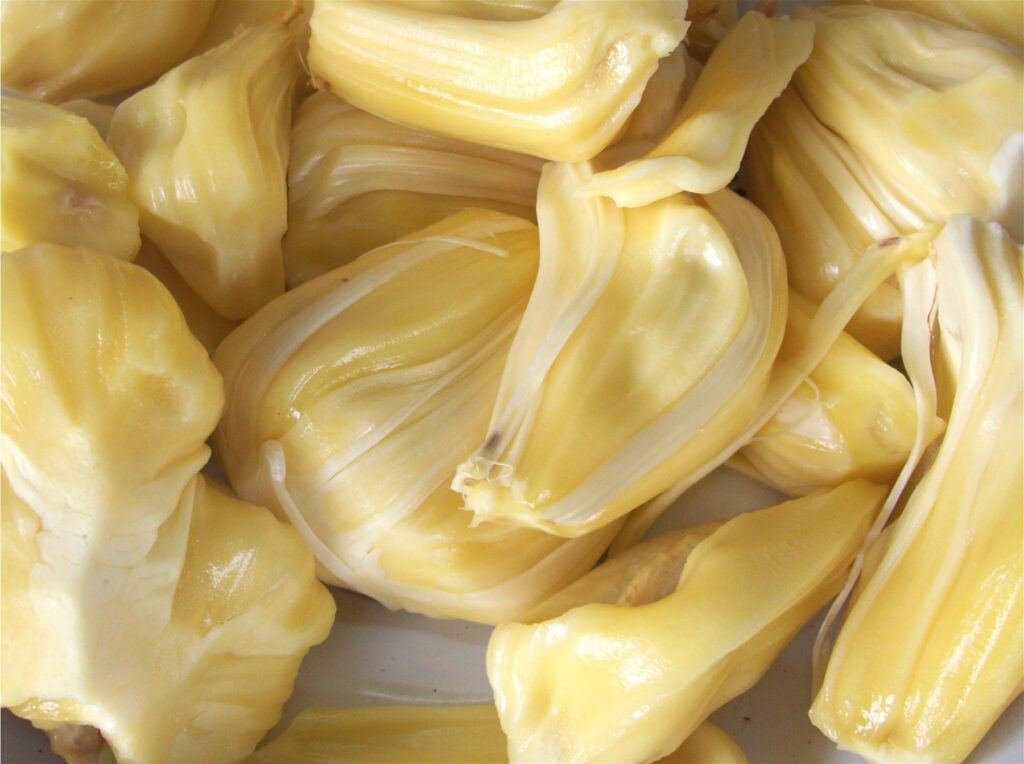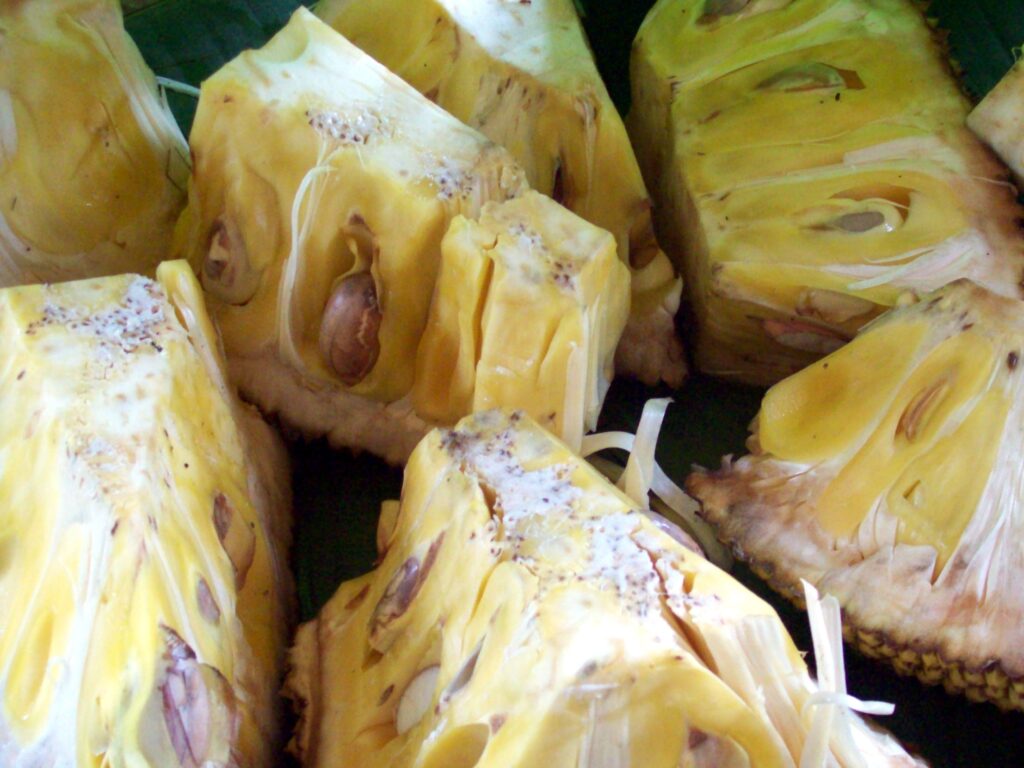Text and Photos by Henrylito D. Tacio
“The world has always been like this: one man feasts on the jackfruit and the other gets stuck in the sap,” says a familiar saying. Another one goes like this, “Whoever eats the jackfruit, will be touched by the sap.”
Jackfruit (scientific name: Artocarpus heterophyllus) is called a variety of names around the world. The English one, jackfruit, is generally cited as deriving from the Malayalam “chakka” or “cakkai” via the Portuguese “jaca,” the name for it used by the physician and naturalist Garcia de Orta in his 1563 book. But a botanist named Ralph Randles Stewart argued that it was named after William Jack (1795-1822), a Scottish botanist who worked for the East India Company in Bengal, Sumatra, and Malaysia.
Like most tropical fruits, Westerners considered jackfruit as somewhat weird and exotic. It is enormous and prickly on the outside, and it looks somewhat like the controversial durian (the fruit that “tastes like heaven but smells like hell”).
Once a jackfruit is cracked open, what you will find inside are pods or “bulbs.” Often referred to as the seeds, these bulbs are actually the fleshy covering for the true seeds or pits, which are round and dark like chestnuts. The fruit juices are incredibly sticky, so people often oil their hands before preparing the fruit.
Jackfruit seems to live up to its seems. It has several uses. “For farmers with limited land who are striving to meet needs for wood products, animal feed and above all, household food security, the jackfruit is godsend,” said Dr. John Raintree. He used to be the coordinator of the Artocarpus Network of Winrock International.
In the Philippines, where it is called “langka” or “nangka,” it is being groomed as “the next star of the country’s high value crops,” to quote the words of Agriculture Secretary Emmanuel Piñol. The reason: the “demand for the fruit has increased over the years.”

In his Facebook, Piñol wrote: “The irony of it all is that while the ‘langka’ naturally grows in the Philippines, the demand for its sweet and fleshy fruit by food processors has been so tremendous that local farmers could not supply the needed volume.”
According to the agriculture secretary, the Philippines reportedly imports about P500-million worth of frozen jackfruits every year from its neighboring countries, particularly Vietnam and Thailand.
“Langka” is very popular in the country as it is used by ice cream processors and the makers of “turon,” a Filipino delicacy where a slice of “langka” is embedded in the middle of the fried banana.
If jackfruit is good for human beings, it is also suitable for livestock. In fact, if a farmer feeds it to its cattle, it is most likely that the animal’s milk production will increase. A couple from Claveria, Misamis Oriental, found this out by accident.
A report from the National Dairy Authority (NDA) said that Rodrigo Dumaluan and his wife Magdalena started raising cows in 2006. It was the idea of the wife to include cattle in their farm because she grew up on a dairy farm. The couple raised the animals near the jackfruits mixed with other fruit trees.
“They noticed that the animals frequently stayed under the jackfruit trees and started eating the leaves and fruits that they can reach. They feed on the fallen fruits on the ground,” the NDA report said.
The couple thought that cattle, like human beings, find the fruits delicious. So, they started collecting the fruits, chopped them, and fed the whole fruit (including its rind). Jackfruit became an addition to their usual feeding regimen, which included chopped corn, roughage, and concentrates. “They found out that milk started to increase with constant supply of jackfruit in the feed stuff,” the NDA report said.
In the past, jackfruits were harvested when they were already matured. “But since they observed that the animals feed on them even when the fruits are not yet ripe, plus the added benefit of increased milk production, they prioritized to supply it as feedstuff to their herd,” said the NDA report.
The Dumaluans don’t know what made the cattle produce more milk. But one thing they discover: their cattle produce a good volume of milk. Most of the animals they raised are way past the peak of milk production and ready to dry – and yet the herd produces 80 liters of milk – or an average of 8.8 liters per cow per day.
Meanwhile, many Filipino rice farmers still regard golden apple snails as a menace. Perhaps they can learn a trick from Malaysian farmers who control the snails simply by using rotten jackfruit as bait. This method has proven to be “highly successful,” according to a paper presented during a workshop convened by the Taiwan-based Food and Fertilizer Technology Center (FFTC).

This is how it is done: Freshly rotted jackfruits, which have a strong smell, are collected. A suitable spot is chosen where these baits can be placed above the water. The chosen spot should have running water and populated with golden snails.
The bait is left overnight in the chosen spot. The snails that have gathered on and around the jackfruit are collected in the morning. The snails can either be destroyed or used as feed for ducks.
As it is the jack of all fruits, jackfruit has other uses. In the Philippines, young or immature fruit is also used as a vegetable. Industrial processors utilize the young fruit as an ingredient in the manufacture of a fish sauce known locally as “patis.”
Although many people eat jackfruit for its delicious taste, only very few are aware of its health benefits.
For instance, jackfruit is a rich source of potassium, with 303 milligrams found in 100 grams of the fruit. Studies show that food rich in potassium helps to lower blood pressure. Therefore, jackfruit has the health benefit of providing relief for anyone who suffers from high blood pressure.
If milk and other dairy products do not suit your palate, jackfruit can help you fulfill your daily requirement of calcium! Apart from calcium (6%), jackfruit also contains a substantial quantity of iron (6%), the mineral that forms the base constituent of the oxygen-carrying red blood cells in your body.
Jackfruit is rich in magnesium, a nutrient which essential in the absorption of calcium, and works with calcium to help strengthen the bone and prevent bone-related disorders like osteoporosis.
By carrying a rich store of vitamin C, jackfruit provides the perfect protection from common cold, fever, and other equally distressing ailments. Vitamin C is a natural and very powerful immunity booster. It augments the actions of the body’s own disease fighters and prevents disease-causing agents from attacking your body.
Jackfruit likewise is an excellent source of vitamin A. Research indicates that vitamin A prevents age-related eye diseases such as macular degeneration and glaucoma from attacking the eyes. These diseases can lead to a permanent loss of eyesight. Thus it is crucial to eat food items that contain enough vitamin A to combat them.
Jackfruit also contains phytonutrients, particularly lignans, isoflavones, and saponins, whose health benefits are wide-ranging. These phytonutrients can prevent cancer cells from forming in the body, lower blood pressure, fight against stomach ulcers, and slow down the degeneration of cells that make the skin look young and vital.
Due to the presence of simple sugars like fructose and sucrose, which give a person almost instant energy, jackfruit is considered an energy-generating fruit. Although it is such, the fruit contains no saturated fats or cholesterol.
Aside from its food value, the jackfruit is also valued for its medicinal properties. In Sri Lanka, the leaves are widely used to treat diabetes, particularly among the elderly. Mature or ripened, fallen leaves are collected, boiled, and drank for this purpose. Collected leaves are also sundried, ground, and mixed in hot water to make a tea that native physicians say helps prevent diabetes. But before using it as such, be sure to consult your doctor.
Filipinos use the charred and powdered leaves against diarrhea, boils, and stomachache. To heal ulcers, the ash of leaves burned with corn and coconut shells are used alone or mixed with coconut oil. Heated fresh leaves are used for wound healing.
The jackfruit is also an important source of timber. In India, the timber is used for making high-quality furniture and musical instruments, as well as building materials. In the Philippines, the wood is prized in the making of guitars and “ukuleles” for resonant quality and beauty.
As a timber, experts say the jackfruit is superior to teak. This must be the reason why palaces in Bali and Macassar were built of jackfruit wood, and the limited supply in Indo-China was once reserved for temples.
In Malaysia, jackfruit is intercropped in durian orchards to provide shade. It is similarly used to shade coffee and orange trees, and in India and Sri Lanka, it is grown to provide shade and living support for black pepper.
In Africa, the trees are utilized for yam support. In Australia, they are used as windbreaks at close spacings. In Bangladesh, jackfruit is an important reforestation species.

